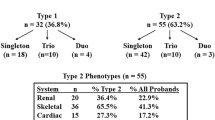Summary
Eleven families segregating for the X-linked recessive immune deficiency disorder, Wiskott-Aldrich syndrome (WAS), were studied by linkage analysis with an alpha satellite DNA probe, pBamX-7, which detects polymorphism at the X chromosome centromere, locus DXZ1, as well as three other polymorphic markers defining loci on the proximal short arm of the X chromosome. Linkage has been established between WAS and DXZ1 (ž (θ)=7.08 at θ=0.03) and WAS and the TIMP gene locus (ž (θ)=5.09 at θ=0.0). We have also confirmed close linkage between DXZ1 and two marker loci, DXS14 and DXS7, previously shown to be linked to the WAS locus. The probe pBamX-7 detected allelic variation in all females tested, reflecting the high frequency of polymorphism at the centromere. One WAS carrier revealed a recombination between WAS and both marker loci DXZ1 and DXS14, indicating that WAS does not map between these loci. In conjunction with previous data from genetic mapping studies of WAS, these results confirm the pericentromerix Xp localization of WAS and demonstrate the usefulness of alpha satelite DNA probes as tools for genetic prediction in WAS as well as other pericentric X-linked diseases.
Similar content being viewed by others
References
Aldrich RA, Steinberg AGI, Campbell DC (1954) Pedigree demonstrating a sex-linked recessive condition characterized by draining ears, eczematoid dermatitis and blood diarrhea. Pediatrics 13:133–138
Aldridge J, Kunkel L, Bruns G, Tantravahi M, Lalande M, Brewster T, Moneau E, Wilson M, Bromley W, Roderick T, Latt SA (1984) A strategy to reveal high-frequency RFLPs along the human X chromosome. Am J Hum Genet 36:546–564
Bhattacharya SS, Wright AF, Clayton JF (1988) A “mileage chart” of part of the X chromosome. Cytogenet Cell Genet 46:580–581
Cooper MD, Chase HP, Lowman JT, Krivit W, Good RA (1968) The Wiskott-Aldrich syndrome: an immunologic deficiency disease involving the afferent limb of immunity. Am J Med 44:499–513
Davies KE, Pearson PL, Harper PS, Murray JM, O'Brien T, Sarfarazi M, Williams R (1983) Linkage analysis of two cloned DNA sequences flanking the Duchenne muscular dystrophy locus on the short arm of the human X chromosome. Nucleic Acids Res 11:2303–2312
Durfy SJ, Clark SC, Williams BRG, Willard HF (1986) RFLP detected by an X-linked CDNA encoding erythroid-potentiating activity/tissue inhibitor of metalloproteinase (EPA/T1MP). Nucleic Acids Res 14:9226
Jorgensen AL, Bostock CJ, Bak AL (1986) Chromosome-specific subfamilies within human alphoid repetitive DNA. J Mol Biol 187:185–196
Kwan S-P, Sandkuyl LA, Blaese M, Kunkel LM, Bruns G, Parmley R, Skarshaug S, Page DC, Ott J, Rosen FS (1988) Genetic mapping of the Wiskott-Aldrich syndrome with two higly-linked polymorphic DNA markers. Genomics 3:39–43
Lathrop GM, Lalouel J-M, White RL (1986) Construction of human linkage maps: likelihood calculations for multilocus linkage analysis. Genet Epidemiol 3:39–52
Mahtani MM, Willard HF (1988) A primary genetic map of the pericentromeric region of the human X chromosome. Genomics 2:294–301
Ochs HD, Slichter SJ, Harker LA, Van Behrens WE, Clark RA, Wedgwood RJ (1980) The Wiskott-Aldrich syndrome: studies of lymphocytes, granulocytes, and platelets. Blood 55:243–252
Oppenheim JJ, Blaese RM, Waldmann TA (1970) Defective lymphocyte transformation and delayed hypersensitivity in Wiskott-Aldrich syndrome. J Immunol 104:835–844
Ott J (1974) Estimation of the recombination fraction in human pedigrees: effecient computation of the likelihood for human linkage studies. Am J Hum Genet 26:588–597
Peacocke M, Siminovitch KA (1987) Linkage of the Wiskott-Aldrich syndrome with polymorphic DNA sequences from the human X chromosome. Proc Natl Acad Sci USA 84:3430–3433
Perry III GS, Spector BD, Schuman LM, Mandel JS, Anderson VE, McHugh RB, Hanson MR, Fahlstrom SM, Krivit W, Kersey JH (1980) The Wiskott-Aldrich syndrome in the United State and Canada. J Pediatr 97:72–78
Willard HF (1985) Chromosome specific organization of human alpha satellite DNA. Am J Hum Genet 37:524–532
Willard HF, Waye JS, Skolnick MH, Schwartz CE, Powers VE, England SB (1986) Detection of restriction fragment length polymorphisms at the centromeres of human chromosomes by using chromosome-specific alpha satellite DNA probes: implications for development of centromeric-based genetic linkage maps. Proc Natl Acad Sci USA 83:5611–5615
Willard HF, Durfy SJ, Mahtani MM, Dorkins H, Davies KE, Williams BRG (1989) Regional localization of the TIMP gene on the human X chromosome. Hum Genet 81:234–238
Author information
Authors and Affiliations
Rights and permissions
About this article
Cite this article
Greer, W.L., Mahtani, M.M., Kwong, P.C. et al. Linkage studies of the Wiskott-Aldrich syndrome: polymorphisms at TIMP and the X chromosome centromere are informative markers for genetic prediction. Hum Genet 83, 227–230 (1989). https://doi.org/10.1007/BF00285161
Received:
Revised:
Issue Date:
DOI: https://doi.org/10.1007/BF00285161




